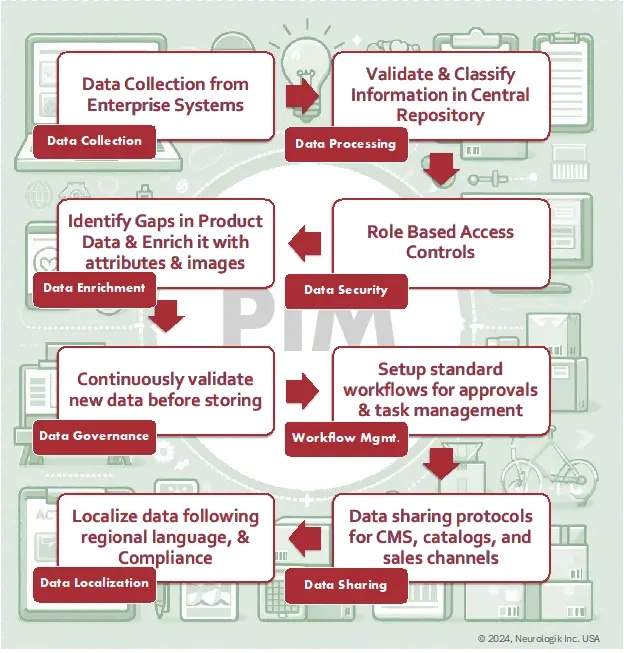PIM Introduction

Brief Overview
North American manufacturers and businesses have recognized the value of their product information early on. Thus, the businesses adopted product information management (PIM) software early and now dominate the world’s PIM revenue share. However, companies in rising economies are realizing this and catching up to their American counterparts. Researchers expect the global PIM markets to grow with a CAGR of 16.7% between 2024 and 2030.
What is Product Information Management (PIM)?
Product information management (PIM) manages all the information related to the product that helps market and sell products through any distribution channels. The distribution channels for PIM can include websites, e-commerce portals, channel partners, governments, and other marketplaces. The information for a PIM system can consist of:
| Multi-lingual Texts | Product Identifiers | User Manuals |
| Text Descriptions | Product Relations | Variants |
| Brand Identifiers | Product Images | Videos |
| CAD Files | Meta Tags | USPs |
Table: Key data types captured by PIM System
PIM is a system for publishers of product data, such as an OEM (original equipment manufacturer), ODM (original design manufacturer), brand owner, retailer (including e-commerce), or independent knowledge creator. The PIM system will define the taxonomy and environments of the product type.
PIM can integrate with the organization’s existing systems and capture structured and unstructured data. After collecting the data, the system can store it in the defined taxonomies and environments. PIM works on defined policies and validation rules for this data validation and storage.
Advanced PIM systems provide a flexible taxonomy framework based on local, domain-specific, and multi-lingual data models. As a core function of the PIM system, it defines the units (cm, CC, inches, etc.) of specifications, conversion rules, and spec value tables.
Core Components of PIM Software
PIM is a modular system consisting of multiple subsystems. These subsystems enable different features and capabilities within a PIM system. Some of them have been around much earlier than PIM. However, PIM forms a meaningful portfolio of these subsystems to create a more valuable enterprise system:
Digital Asset Management (DAM)
Digital assets refer to media files such as PDF, images, and video format files. DAM is usually a tiny part of a more extensive PIM system. However, a separate DAM is better if the primary goal is to manage a lot of metadata (e.g., face/object recognition).
Digital Rights Management (DRM)
Digital rights management ensures read and write access to correct data. For instance, marketing may have read access to all product data, but only the respective product teams have write access to it.
Content Management System (CMS)
A CMS handles a broader variety of data than a PIM system. However, CMS is valuable for producing product information from a PIM to the enterprise website or e-commerce portal.
Product Lifecycle Management (PLM)
PLM contains a lot of data about the entire life of a product from inception to launch and end-of-life (EOL) status. Much of this data will never be available to the public, but some information is critical for buyers, especially in the B2B setting. Thus, the PIM can collect and publish market essential info about the product from PLM.
Master Data Management (MDM)
Master data refers to the single source of truth or the authentic version of product data. PIM system contains this information about all products and may collect inventory and price information from ERP to publish on the e-commerce portal. MDM and PKM can enable a self-service portal for the enterprise.
Vendor or Supplier Central
Enterprises can open their PIM environment to the vendors or suppliers. Integrating the vendor’s ERP or PIM system through APIs allows for seamless and automated data updates.
How Does PIM Software Work?

Why Do Businesses Need a PIM System?
Businesses need PIM software to streamline product information management, enhance customer experience, scale efficiently, improve collaboration, and ensure compliance. PIM can help businesses maintain a competitive edge in today’s market:
“According to Gartner, companies that implement PIM systems report a 20-25% increase in eCommerce conversion rates due to improved product data quality.”
“Forrester states that 50% of B2B customers will likely switch vendors if product information is inconsistent across channels, highlighting the importance of accurate and consistent data.”
| Features | Open-Source PIM | Cloud-Based (SaaS) PIM | On-Premises PIM | Multidomain PIM | Vertical-Specific PIM |
|---|---|---|---|---|---|
| Customization | High | Moderate | High | High | Moderate |
| Deployment | On-premises or cloud | Cloud | On-premises | On-premises or cloud | Cloud or on-premises |
| Data Control | Full | Limited (provider managed) | Full | Full | Moderate to full |
| Scalability | Depends on infrastructure | High (scalable with demand) | Depends on infrastructure | High | Moderate |
| Industry Focus | General | General | General | General | Specific (e.g., fashion, retail) |
| Integration Capabilities | Extensive, requires development | Extensive, often plug-and-play | Extensive, requires IT support | Extensive, across multiple domains | Moderate, industry-specific |
| Cost | Free (excluding development costs) | Subscription-based, flexible pricing | High initial cost, ongoing expenses | High | Varies (usually industry-dependent) |
| Maintenance | Requires in-house team | Managed by provider | Requires in-house team | Managed by provider or in-house | Varies (managed or in-house) |
| Security | Depends on implementation | Managed by provider, regular updates | High, managed internally | High | Varies (depends on deployment) |
| Community Support | Strong (community-driven) | Provider-driven | Limited, vendor support | Vendor-driven | Limited, specialized support |
| Time-to-Market | Moderate (development required) | Fast | Slow (requires setup) | Moderate | Fast |
| Workflow Management | Customizable | Standardized, with options | Customizable | Extensive, across domains | Tailored to industry workflows |
| Multi-Channel Distribution | Customizable | Standardized, with options | Customizable | Extensive | Tailored to industry channels |
| Analytics and Reporting | Depends on implementation | Built-in, with customization options | Customizable | Extensive, cross-domain reporting | Industry-specific reporting |
| Regulatory Compliance | Requires customization | Managed by the provider, standardized | Customizable | Cross-domain compliance features | Tailored to industry regulations |
Table: Different Types of PIM Systems & their Key Features
Different Types of PIM Systems
You can explore various types of Product Information Management (PIM) systems to address specific business needs and use cases. The correct PIM system choice depends on your company’s size, industry, IT resources, and data management needs.
Here’s a breakdown of the different types of PIM systems and how they differ from each other:
Difference: Open-source PIM systems offer unparalleled customization and control but require technical expertise to implement and maintain.
Difference: SaaS PIM systems are easy to deploy and manage, with predictable costs and automatic updates. However, they offer less customization than open-source solutions.
Difference: On-premise PIM systems offer maximum control and security but have a higher cost and need internal IT support.
Difference: Multidomain PIM systems are comprehensive and can handle more than just product data. They are suitable for large organizations with complex data management needs.
Difference: Vertical-specific PIM systems provide industry-focused, out-of-the-box features, reducing the need for customization but limiting flexibility across industries.
Key Differences
Customization
Open-source systems offer maximum customization. SaaS and vertical-specific PIM systems offer less but are more accessible to deploy.
Deployment Model
On-premise systems provide total control but require internal resources. However, cloud-based systems offer easy use with automatic updates and scalability.
Scope of Data Management
Multidomain systems handle multiple data types across the organization, whereas traditional PIM systems focus primarily on product information.
Industry Focus
Vertical-specific PIM systems are designed for specific industries, providing tailored features. Whereas generic PIM systems cater to a broader audience.
SaaS PIM for B2B Manufacturers
Neurologik’s ProductHub is a cloud-based PIM system addressing the need for product information management for B2B manufacturers. ProductHub offers a product data management environment to capture, enrich, and distribute product data across internal and external teams.
The PIM platform enables real-time collaboration and secure access to the unified product data across the supply chain. Dig deeper into how ProductHub provides the ground for an unbeatable competitive advantage for your organization.
Key Features & Capabilities of ProductHub
| Content Onboarding | Data Quality | Cost Efficiency |
| Content Governance | User Experience | Partner Integration |
| Content Enrichment | Market Adaptability | Global Operations |
| Distribution Channels | Compliance | Product Configuration |
| Search & Filtering |
Pricing for Neurologik PIM
Neurologik’s ProductHub is a modular SaaS PIM solution, and enterprise pricing can vary based on several factors. You can connect with the business consulting team at Neurologik to discover the custom pricing for your business.
Frequently Asked Questions
- Centralized data management
- Multi-channel distribution
- Integration with ERP, CRM, and e-commerce systems
- Data enrichment and standardization
- Customizable workflows
- Scalability to grow with your catalog
- Localization and translation support
- Robust analytics and reporting
- User-friendly interface
- Data security and compliance